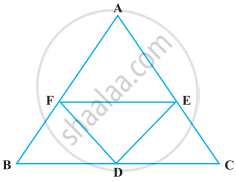Advertisements
Advertisements
प्रश्न
In the Figure, ABCD is a rectangle and EFGH is a parallelogram. Using the measurements given in the figure, what is the length d of the segment that is perpendicular to `bar("HE")` and `bar("FG")`?
उत्तर
In the given figure ABCD is a rectangle and EFGH is a parallelogram.
In the right triangle AEH
HE = `sqrt("AH"^2 + "AE"^2)`
= `sqrt(3^2 + 4^2)`
= `sqrt(9 + 16)`
= `sqrt(25)`
HE = 5
∴ GF = 5 ...(HE and Gf are opposite sides of a parallelogram)
In the right triangle
GC = `sqrt("GF"^2 - "FC"^2)`
= `sqrt(5^2 - 3^2)`
= `sqrt(25 - 9)`
= `sqrt(16)`
∴ DG = 10 – 6 = 4
Area of ΔAEH + Area of ΔBEF + Area of ΔFCG + Area of ΔHDG
= `1/2 xx 3 xx 4 + 1/2 xx 6 xx 5 + 1/2 xx 3 xx 4 + 1/2 xx 5 xx 6`
= (6 + 15 + 6 + 15)
= 42
∴ Area of 4 triangles = 42
Area of the parallelogram = Area of the rectangle ABCD – Area of 4 triangles.
= 10 × 8 – 42
= 80 – 42
= 38
b × h = 38
5 × d = 38
d = `38/5`
= `7 3/5`
Length of d = `7 3/5` or 7.6
APPEARS IN
संबंधित प्रश्न
In the given figure, ABCD is a parallelogram.
Prove that: AB = 2 BC.
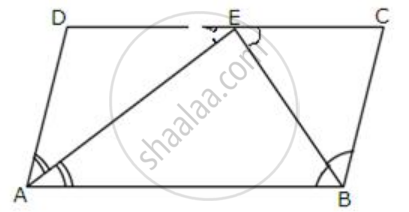
The following figure shows a trapezium ABCD in which AB is parallel to DC and AD = BC. 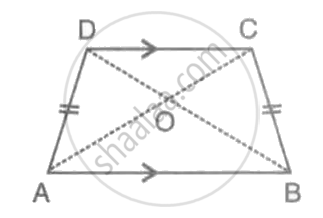
Prove that:
(i) ∠DAB = ∠CBA
(ii) ∠ADC = ∠BCD
(iii) AC = BD
(iv) OA = OB and OC = OD.
In parallelogram ABCD, the bisector of angle A meets DC at P and AB = 2 AD.
Prove that:
(i) BP bisects angle B.
(ii) Angle APB = 90o.
Points M and N are taken on the diagonal AC of a parallelogram ABCD such that AM = CN. Prove that BMDN is a parallelogram.
PQRS is a parallelogram. T is the mid-point of PQ and ST bisects ∠PSR.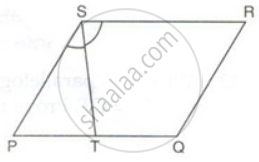
Prove that: ∠RTS = 90°
In the given figure, MP is the bisector of ∠P and RN is the bisector of ∠R of parallelogram PQRS. Prove that PMRN is a parallelogram.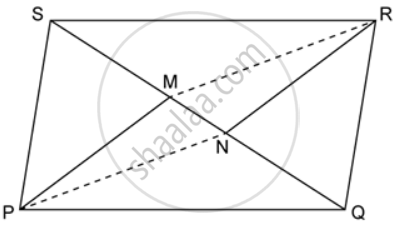
Find the perimeter of the parallelogram PQRS.

In parallelogram ABCD of the accompanying diagram, line DP is drawn bisecting BC at N and meeting AB (extended) at P. From vertex C, line CQ is drawn bisecting side AD at M and meeting AB (extended) at Q. Lines DP and CQ meet at O. Show that the area of triangle QPO is `9/8` of the area of the parallelogram ABCD
Which of the following statement is correct?
In the following figure, it is given that BDEF and FDCE are parallelograms. Can you say that BD = CD? Why or why not?
